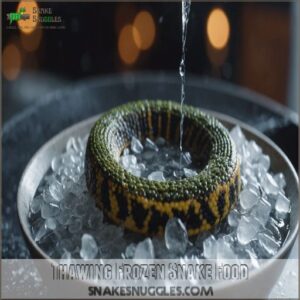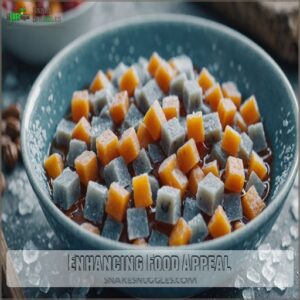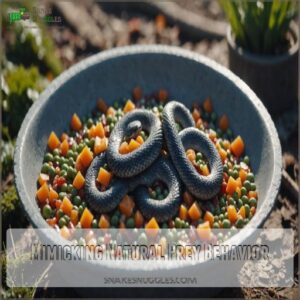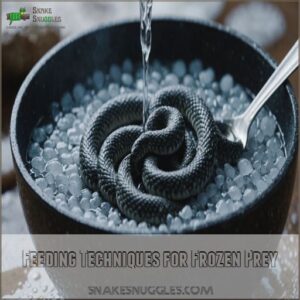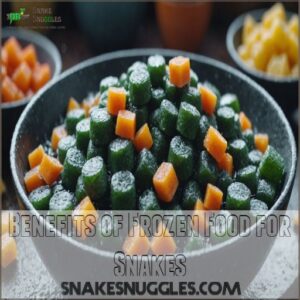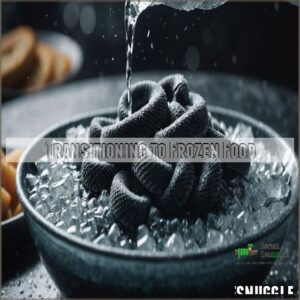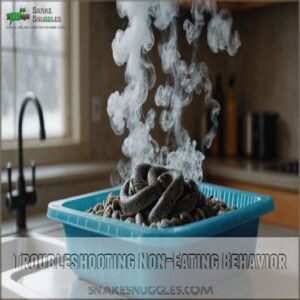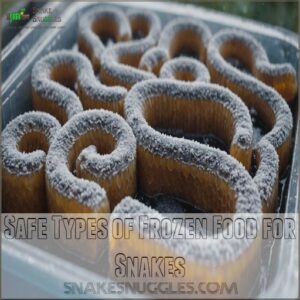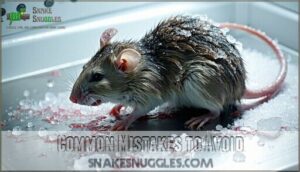This site is supported by our readers. We may earn a commission, at no cost to you, if you purchase through links.
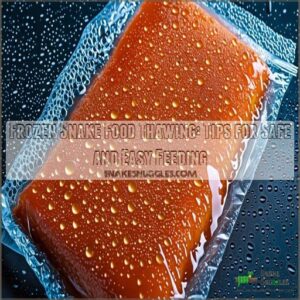
Start by placing the frozen prey in your fridge a day before feeding. This helps it thaw safely, avoiding bacteria-driven nightmare scenarios. Don’t let it lounge at room temperature too long.
When you’re ready, warm it in a shallow dish under warm, dripping water until it feels like it just left a cozy sunspot. It’s like a spa day for mice! This simple routine makes sure your snake gets a safe and tasty meal.
Curious about making thawed prey extra irresistible? Stick around for more slithering secrets.
Table Of Contents
- Key Takeaways
- Thawing Frozen Snake Food
- Preparing Frozen Prey for Feeding
- Feeding Techniques for Frozen Prey
- Benefits of Frozen Food for Snakes
- Transitioning to Frozen Food
- Troubleshooting Non-Eating Behavior
- Safe Types of Frozen Food for Snakes
- Feeding Frequency and Portions
- Reducing Stress During Feeding
- Common Mistakes to Avoid
- Frequently Asked Questions (FAQs)
- Can snakes eat frozen food?
- Can snakes eat thawed prey?
- How do you Thaw a snake?
- Should I Feed my snake frozen or thawed?
- How do you prepare frozen food for snakes?
- How do you feed a frozen thawed rat to a ball python?
- How long can I leave a frozen thawed rat with ball python?
- Can you feed snakes frozen food?
- What storage methods extend frozen prey shelf life?
- How do you dispose of unused thawed prey?
- Are there nutritional differences in frozen prey?
- Can you use scented lures with frozen food?
- How do climate conditions affect thawing methods?
- Conclusion
Key Takeaways
- It’s essential to handle thawed prey with tongs to mimic live prey movement, and you can learn more about feeding techniques with tongs. You should thaw frozen snake food safely in the refrigerator or using a cold water bath to avoid bacterial growth. Never microwave or refreeze.
- Match the prey size to your snake’s body width to prevent choking hazards.
- Warm the thawed prey to a temperature that mimics natural body heat (around 100-110°F) to make it more appealing.
- Monitor your snake’s health and adjust feeding techniques as needed; consult a vet if your snake consistently refuses food.
Thawing Frozen Snake Food
When thawing frozen snake food, you want to make sure the prey is safe and palatable for your pet.
Use methods like refrigerator thawing and cold water baths.
Avoid microwaving to prevent accidentally cooking the rodent.
Safe Thawing Practices
Thawing frozen snake food safely is important to keep your snake’s varied diet on track using tips on ethical food sourcing. Thawing frozen snake food safely is important to keep your slithery friend healthy.
Avoid bacteria risks by following safe thawing practices.
Use a sealed plastic bag to thaw frozen rodents in cold water for 30-60 minutes, ensuring water safety.
Control the temperature carefully to create thawed food that’s just right.
Remember, never refreeze once thawed—freezer storage is key.
Refrigerator Thawing Techniques
For safe frozen snake food thawing, refrigerator thawing techniques are your best bet.
It’s slow but steady, minimizing safety concerns.
Here’s how: To make sure the frozen rodent reaches a safe temperature for your snake, you can use a temperature gun to check for the safe range, as recommended on a thawing guide.
Place your frozen rodent in a sealed bag.
Put it on a plate to catch any drips.
Let it thaw overnight in the fridge.
This ensures even thawing, reducing freezer burn.
Check the thawing time; it depends on the size of the prey.
Remember, patience is key!
Cold Water Thawing Methods
Imagine you’ve got frozen food for your snake, and you’re wondering how to thaw it safely.
Consider cold water thawing.
Submerge the sealed bag in cold water, making sure the right bag size and water changes every 30 minutes.
This method, balancing time and safety precautions, makes sure your snake’s meal is prepped perfectly, promoting excellent snake nutrition and care.
Hot Water Thawing Precautions
Cold water methods are great, but when using hot water, keep an eye on temperature control and water resistance.
Make sure bag integrity to prevent bacterial growth, maintaining your prey’s quality.
Cooking the rodent with hot water might make it less appetizing.
Stick to snake feeding precautions: warm food, not a hot mess.
Your trusty frozen rodents thank you!
Preparing Frozen Prey for Feeding
When preparing frozen prey for your snake, focus on making it as irresistible as possible.
By adding appealing scents like lizard body odor or chicken broth, and mimicking natural prey behavior, you can encourage your snake to eat enthusiastically.
Enhancing Food Appeal
Ever wondered how to make frozen prey irresistible for your snake? Enhance its appeal using these tips:
- Brain scent: Puncture the brain for a tempting aroma.
- Color variation: Offer different-colored prey.
- Blow dryer method: Warm with a blow dryer for scent.
- Natural behavior: Move prey to mimic live action.
- Cage environment: Leave prey overnight to entice.
Scenting Prey With Lizard Body Scent
Boost the appeal of frozen rodents by scenting them with lizard body scent.
This method capitalizes on scent effectiveness to trigger your snake’s feeding response.
Gently rub the prey with a scent-infused cloth or add it to a container with blended scents.
This inexpensive trick can attract even the pickiest eaters, increasing feeding frequency and ensuring your snake remains healthy.
Using Chicken Broth to Add Moisture
Adding a little chicken broth enhances the appeal of frozen prey for your snake.
The broth’s moisture adds a tempting flavor, making feeding time easier.
1. Choose low-sodium broth for safety.
2. Lightly dip thawed prey.
3. Monitor your snake’s response.
For optimal feeding, consider the ball python’s age and size when determining the meal frequency, as young pythons typically eat more often with a consistent feeding schedule. Adjust the frequency based on your snake’s feeding schedule and preferences.
It’s a simple way to spice things up!
Mimicking Natural Prey Behavior
Before feeding, subtly mimic natural prey.
Gently move the thawed rodent using tongs, simulating a struggling mouse.
This triggers your snake’s hunting instincts, making the frozen prey more appealing.
Remember, even though it’s frozen, you can still make it exciting!
This simple technique improves feeding success by reducing the stress and alarm that can come with feeding live prey, which is a safer alternative as discussed in the pros and cons of feeding live rodents to snakes live rodents vs frozen. This simple technique improves feeding success and enhances the overall snake care experience.
Proper husbandry includes understanding these prey movement cues.
Feeding Techniques for Frozen Prey
When feeding your snake frozen prey, use tongs to handle the thawed rodent, gently mimicking natural movements to engage their hunting instincts.
Frozen prey should be thawed before feeding.
Make sure the prey size matches the snake’s girth and adjust feeding times to match its natural activity patterns, whether diurnal or nocturnal.
Using Tongs to Handle Prey
Enhancing the appeal of your snake’s meal now leads us to skillful feeding.
Using tongs for snake feeding isn’t just safer; it mimics natural prey movement.
Tongs vs. hands is a no-brainer: no bites!
Remember these tips:
- Protect your fingers – keep those digits safe.
- Natural look – moving prey attracts.
- Reduce stress – offer a safe feeding environment.
Timing of Feeding for Diurnal and Nocturnal Snakes
While using tongs to handle prey, think about feeding timing too.
Diurnal snakes prefer daytime feeding, aligning with their natural snake activity.
Nighttime feeding suits nocturnal snakes—they hunt when the moon’s out.
Tailor feeding schedules to your pet snake’s rhythm.
Look for hunger cues like tongue flicking, ensuring the ideal temperature range in their habitat.
It’s all about effective reptile husbandry!
Ensuring Proper Prey Size
Snakes eat better when the prey matches their body’s widest part, so size matters. Think of this as fitting shoes; too big, and there’s trouble.
1. Compare the prey’s thickness with your snake’s body.
2. Adjust as the snake grows to prevent choking risks.
3. Keep feeding frequency in tune with natural prey behavior for calmer feeding sessions.
Benefits of Frozen Food for Snakes
You’ll find frozen snake food both convenient and cost-effective, eliminating the hassle of handling live prey while saving money.
Plus, it reduces the risk of injuries from live prey and provides balanced nutrition for your pet snake.
Convenience and Cost-Effectiveness
Maximize your freezer space, save time, and cut costs with frozen snake food.
It’s a budget-friendly feeding option—buy in bulk without worrying about spoilage.
Plus, you’ll avoid soiled bedding and maintain temperature control for snakes on regular schedules, even those nocturnal critters.
Proper handling, such as thawing frozen mice safely, can also minimize bacterial growth and retain nutritional value.
Here’s a quick table to lay out these benefits:
| Benefit | Description | Example |
|---|---|---|
| Bulk Buying | Purchase large quantities | Save money over time |
| Long-term Savings | Less frequent buying needed | Freeze for months |
| Temperature Control | Consistent feeding times | Keeps food fresh |
Reduced Risk of Live Prey Injuries
Frozen food offers more than just convenience; it greatly improves snake safety.
Using frozen prey eliminates the risk of injuries from struggling live rodents.
This makes sure your snake’s welfare and reduces stress during feeding.
It’s a win-win for both you and your scaly friend!
Ethical feeding practices are easier to maintain with this method, simplifying prey control and promoting humane handling.
You’ll have peace of mind knowing your snake is safe and happy.
Nutritional Value of Frozen Prey
After minimizing the danger of live prey attacks, think about what’s on the menu.
Frozen prey often retains essential nutrients, ensuring your snake gets a balanced diet.
You don’t need to worry much about nutrient loss, and supplement needs drop.
Plus, prey quality remains consistent, offering reliability in feeding frequency.
Proper frozen rodent thawing products, like those found at reptile food shops, can also help maintain the health and well-being of your snake.
It’s a win-win for you and your reptile friend.
Transitioning to Frozen Food
Switching your snake to frozen food can seem tricky, but starting with pre-killed prey and gradually introducing frozen options will help.
Keep an eye on your snake’s health and behavior to make sure a smooth and stress-free adjustment happens.
Starting With Pre-Killed Prey
When you’re easing into the realm of pre-killed prey, think of it as a gentle handshake, not a wrestling match.
Pre-killed prey benefits include reduced stress for both you and your snake.
It’s a safe start for beginners exploring the live vs. pre-killed debate, ensuring your pet doesn’t face any accidental bites.
Safety first, enjoyment next!
Gradually Introducing Frozen Prey
Switching your snake to frozen prey can feel scary, but start small.
To simplify the process, you can utilize products specifically designed for reptile food thawing, such as those found in reptile food thawing kits.
Kick off the weaning process by offering thawed, pre-killed prey alongside live ones for gradual prey acceptance.
Observe your snake’s reaction; scent training can help ease the change.
Maintain a consistent feeding routine, patiently encouraging your snake to embrace these new choices with positive reinforcement.
Monitoring Snake’s Health and Behavior
Keeping a keen eye on your snake’s health and behavior during the change to frozen food is very important.
Watch for shedding, weight changes, activity levels, appetite changes, and defecation patterns.
Be aware that changes in these areas could be signs of a snake disease or condition, such as stomatitis or mouth rot.
These indicators clue you in on how the switch affects them.
If your snake acts differently or looks unwell, a vet visit is wise.
It’s like being a snake sleuth!
Troubleshooting Non-Eating Behavior
When your snake turns its nose up at thawed prey, it can be puzzling, but understanding a few key troubleshooting tactics can help.
Thawed prey can be a picky eater, so make sure you’re offering the correct temperature and scent.
If your snake’s appetite doesn’t improve, consider consulting a vet.
Identifying Signs of Hunger and Illness
Is your snake refusing meals?
Notice increased tongue flicking, a sign of hunger.
Weight loss, lethargy, or a lack of defecation could indicate illness.
It’s also essential to recognize natural behavior like seasonal fasting patterns, where snakes may refuse food during shedding or breeding season.
Remember, snakes don’t eat while shedding.
If you see these signs, don’t panic!
Observe carefully, and if you’re worried, consult a veterinarian.
Early detection is key to keeping your scaly friend healthy and happy.
Adjusting Thawing and Feeding Techniques
Spotting your snake’s reluctance to eat? Adjust thawing times—instead of overnight fridge thawing, try cold water methods for quicker results.
Check that prey size fits your snake’s body width, and tweak feeding frequency according to age.
Enhance scenting techniques by adding chicken broth or a lizard’s scent.
With these handling methods, your snake might just take a bite.
Consulting a Veterinarian for Assistance
Every snake owner occasionally faces a stubborn eater.
If your snake continually snubs its food, don’t stress—get a vet involved.
A snake’s habitat and environment play a crucial role in its overall health, and it’s essential to create a thermal gradient to mimic its natural environment. A qualified veterinarian can assess possible snake health issues or suggest nutritional advice and medication needs, offering preventative care.
They’ll equip you with the professional insight to tackle feeding problems effectively, ensuring your pet’s wellbeing and your peace of mind.
Safe Types of Frozen Food for Snakes
When selecting frozen food for your snake, choose prey items that match your snake’s size and nutritional needs.
Reputable suppliers help minimize bacterial risks and guarantee you’re getting safe, high-quality options.
Choosing The Right Prey Size and Type
Thinking your snake’s not eating? It might need the right prey size and type! Here’s a handy guide:
- Prey Species: Choose prey that matches your snake’s age and size.
- Prey Variety: Offer different types to keep things interesting.
- Prey Availability: Make sure there’s a consistent supply to maintain feeding frequency.
Keeping these in mind can make mealtime smoother and more satisfying!
Avoiding Prey With High Bacterial Risk
To dodge bacterial risks in snake food, handle with care!
Store frozen prey properly and keep it within recommended storage times to prevent bacterial growth.
Test for bacteria when in doubt, ensuring prey is healthy.
Follow food safety guidelines closely, using prey that shows minimal spoilage signs.
Remember, healthy rodents mean a healthier snake, making feeding stress-free.
Selecting Reputable Frozen Food Suppliers
Finding a reputable frozen snake food supplier is like hitting the jackpot for your pet’s diet.
Make sure they prioritize quality control and food safety, offering a range of prey options.
Check customer reviews and their customer service to gauge reliability.
You want prey that’s fresh, diverse, and handled with care, ensuring both you and your snake are happy.
Feeding Frequency and Portions
To determine your snake’s ideal feeding schedule, it’s essential to consider the recommended feeding frequency, such as feeding young snakes every 5-7 days for the first 6-7 months as outlined in Ball Python Feeding Schedule, considering its age and size.
This involves adjusting portion sizes to guarantee proper growth and health while monitoring your snake’s weight for any issues.
Determining Snake’s Feeding Schedule
Wondering how often to feed your snake? Look at its age and growth rate. Hatchlings eat more often, maybe twice a week, while adults might eat weekly.
Keep an eye on the snake’s health status, ensuring it’s active and thriving.
Adjust feeding frequency based on appetite and activity—just like us, snakes have their preferences!
Adjusting Portion Sizes Based on Snake’s Age and Size
Right on the heels of setting a feeding schedule, you’ll want to adjust portion sizes to fit your snake’s age and size.
For a convenient and hassle-free way to purchase the right food, check out online stores like those offering frozen snake food.
With snake growth, a handy feeding chart keeps you from going overboard.
Young snakes might gobble more often, while adult snakes prefer larger, spaced-out meals.
Mindful portion size keeps your snake satisfied and healthy.
Monitoring Snake’s Weight and Health
Keep tabs on your snake’s weight as a sign of health, like a detective tracking clues.
Adjust feeding based on shedding cycles—snakes often skip meals then.
Appetite changes signal health shifts; monitor fecal consistency, as it’s a window into digestion.
Snake behavior, like tongue flicking or activity changes, hints at their well-being.
Stay observant!
Reducing Stress During Feeding
To reduce stress during feeding, you can create a naturalistic environment by minimizing handling and disturbances, which helps your snake feel more at ease.
Scent and visual cues also stimulate your snake’s appetite, making feeding time less stressful for both of you.
Creating a Naturalistic Feeding Environment
Balancing feeding frequency involves more than just timing.
To create a naturalistic feeding environment and reduce stress, think like your scaly friend.
Focus on:
- Enclosure Design: Mimic natural habitats.
- Hiding Spots: Provide security.
- Prey Movement: Imitate real prey behavior.
- Lighting Effects: Use dim, natural lighting.
- Sensory Stimulation: Include scents or sounds.
These tips help your snake eat relaxed and happy!
Minimizing Handling and Disturbance
Think about your snake’s natural hunting style while considering its comfort.
It’s important to minimize handling and disruption during feeding.
Too much fuss can spike Snake Stress, making mealtime less inviting.
Set up the Cage with soothing elements and cleverly position the Prey for effective Feeding.
Use gentle movements to alleviate anxiety, keeping the Enclosure Design calm and purposeful.
Using Scent and Visual Cues to Stimulate Appetite
Sometimes, even the tastiest frozen rodent needs a little extra oomph!
Try scent training; a tiny drop of lizard scent on the prey can work wonders.
Good prey presentation is key; mimic natural behaviors by slightly moving the thawed rodent.
Visual triggers matter too; consider using contrasting colors to pique your snake’s interest.
These appetite enhancers can make all the difference!
Common Mistakes to Avoid
When thawing frozen snake food, it’s important to avoid common mistakes that could affect your pet’s health.
Avoid improper thawing techniques, inadequate prey size or type, and always monitor your snake’s health to guarantee a safe and satisfying meal.
Improper Thawing Techniques
A common mistake when thawing frozen snake food is using marshmallow-soft techniques.
Avoid these pitfalls:
- Microwaving: It can cook the prey, making it unappetizing.
- Refreezing: This leads to bacteria growth, risking your snake’s health.
- Hot water: It thaws unevenly, affecting thawing time and quality.
Opt for safer, more effective methods instead.
Inadequate Prey Size and Type
After ensuring proper thawing, focus on choosing the right prey size and type.
Imagine serving a lion salad—not really his thing, right?
Match the prey-to-snake ratio to your snake’s size.
Opt for species that align with his natural diet.
Size variation matters!
Available options might tempt poorly matched selections, undermining nutritional needs and potentially disrupting your snake’s feeding success.
Insufficient Monitoring of Snake’s Health and Behavior
Neglecting regular checks on your snake’s health leads to sneaky problems like shedding, weight loss, or appetite changes.
Keep an eye out for unusual breathing issues or defecation problems, and make sure you’re following proper snake quarantine procedures, as respiratory issues can manifest as bubbles or mucus around the mouth or nostrils, wheezing or clicking sounds, and open-mouth breathing.
Regular monitoring makes sure you’re not left in the dark about your pet’s well-being.
Remember, proactive care avoids drama—and veterinary visits—making your snake’s life a smooth journey instead of a bumpy ride.
Frequently Asked Questions (FAQs)
Can snakes eat frozen food?
Thawing frozen rodents safely is very important.
You must thaw them properly in the refrigerator, never using a microwave.
Make sure the prey’s size matches your snake’s body thickness for a successful feeding.
Can snakes eat thawed prey?
Yes, snakes can eat thawed prey.
Make sure to thaw it safely in the fridge and warm it to around 100-110°F.
This replicates natural body heat, encouraging your snake’s appetite and simplifying feeding time.
How do you Thaw a snake?
Thawing snakes isn’t a common practice since reptiles are live creatures!
However, if you’re thawing snake food, place frozen rodents in a sealed bag, submerge in cold water for 30-60 minutes, then warm gently.
Should I Feed my snake frozen or thawed?
You should always feed your snake thawed prey to guarantee safe consumption.
Frozen prey can cause digestive issues and damage your snake’s digestive tract.
Thawing also mimics natural food conditions, making the meal more appealing.
How do you prepare frozen food for snakes?
Start by thawing the frozen rodent in the refrigerator overnight, or submerge it in cold water for faster results.
Warm to 100-110°F using hot water.
Don’t use the microwave or refreeze once thawed.
How do you feed a frozen thawed rat to a ball python?
To feed a ball python a frozen thawed rat, gently warm the rat in warm water.
Then use tongs to offer it near the snake’s head.
Mimic live prey movement and allow the snake to strike naturally.
How long can I leave a frozen thawed rat with ball python?
Leave a frozen thawed rat with your ball python for no more than 24 hours.
If it remains uneaten, remove it to prevent spoilage and odors.
This approach maintains hygiene and keeps your snake’s habitat fresh.
Can you feed snakes frozen food?
Yes, you can!
Did you know that 90% of snake owners successfully feed frozen rodents?
Thaw it safely, then offer it using tongs to mimic live prey.
Your snake will thank you!
What storage methods extend frozen prey shelf life?
You want your snake’s food to stay fresh, so store frozen prey in airtight bags to prevent freezer burn.
Keep the freezer at a consistent temperature below 0°F.
Use the prey within six months.
How do you dispose of unused thawed prey?
Toss unused thawed prey like it’s yesterday’s leftover mystery meat.
Wrap it securely in a plastic bag and toss it in the trash.
Don’t refreeze or compost it, as this can invite bacteria and unpleasant critters.
Are there nutritional differences in frozen prey?
Frozen prey generally retains its nutritional value over time, but improper storage might lead to nutrient loss.
Frozen prey generally retains its nutritional value over time, but improper storage might lead to nutrient loss.
Keeping prey frozen below -18°C (-4°F) preserves their quality, ensuring your snake gets a balanced, nutritious meal.
Can you use scented lures with frozen food?
Harness the power of scented lures with frozen food to captivate your snake’s senses!
Use chicken broth for moisture or rub prey with lizard scent; these tricks can entice even the most stubborn snake to dine.
How do climate conditions affect thawing methods?
Warmer climates speed up thawing, which can risk bacteria growth if not managed well.
Thawing in colder conditions slows the process, needing longer times or altered techniques.
Always adjust methods according to your environment for safety and effectiveness.
Conclusion
Surveys show that 60% of reptile owners prefer frozen over live prey.
Proper frozen snake food thawing isn’t just about convenience—it’s vital for your snake’s health.
Following these methods guarantees a safe, nutritional meal and fosters healthy feeding habits.
Remember, each snake has its own quirks; some might appreciate a little extra scent on their meal or a quieter vibe during feeding time.
By minding these details, you’re giving your snake a safe, satisfying dining experience.

